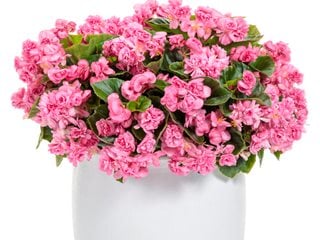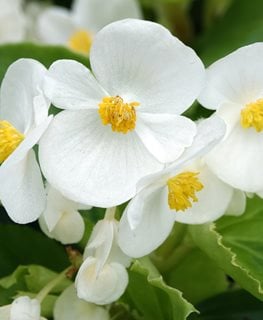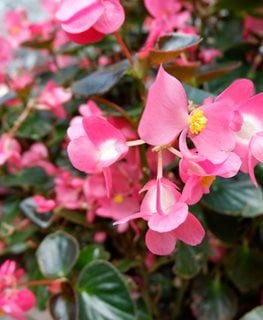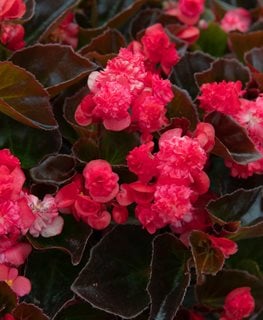Grow Wax Begonias for Nonstop Summer Blooms
Learn how to use these easy-care flowering plants to add long-lasting color to garden beds and borders, containers, and hanging baskets
Double Up™ Pink begonia. Photo by: Proven Winners
If you could somehow combine a succulent with an impatiens plant, it would probably look a lot like a wax begonia. But unlike most impatiens, wax begonias grow as well in full sunlight as they do in shade, making them one of the most versatile plants in the garden. What’s more, these tough little plants are a breeze to care for and need little more than occasional watering during dry weather.
Wish you could enjoy wax begonias year-round? You can! A wax begonia is fibrous-rooted, which means it doesn’t go through a period of dormancy like its tuberous-rooted cousins. In the fall, simply pot up your begonias and grow them as houseplants indoors, where they will bloom continuously under the right conditions. (Learn more about the different types of begonias.)
On this page: Basics | Planting | Care and Maintenance | Pictures | FAQ's
On this page:
BASICS
Botanical name:
Begonia semperflorens (semperflorens means "always flowering") and Begonia x benariensis
Hardiness Zones:
9-11, typically grown as an annual or houseplant
Growth habit:
Mounding
Height/spread:
6 to 24 inches tall and wide
Exposure:
Shade to full sun
Bloom time:
Late spring until frost
Flowers:
Single or double flowers up to 2 inches across come in shades of red, pink, or white. Most have prominent yellow stamens.
Foliage:
The rounded, waxy leaves are usually green or bronze, but you can also find hybrids with variegated foliage.
Special attributes:
Ever-blooming, heat tolerant, rabbit and deer resistant, self-cleaning, few insect or disease problems.
PLANTING WAX BEGONIAS

Surefire® Red begonia (center). Photo by: Proven Winners.
When to plant:
In late spring, after all threat of frost has passed and when temperatures stay above 50 degrees F at night.
Where to plant:
A location that receives partial shade is best, but plants will also tolerate full sun. In hot southern climates, protect plants from harsh afternoon sunlight.
How to plant:
Wax begonias are easiest to grow from nursery-grown plants transplanted into the garden in spring. Begonias can also be planted from seed, but because the seeds have a long germination period, you’ll need to start them indoors about 12 weeks before the last expected frost date.
Soil:
Grow in fertile, well-draining soil amended with organic matter.
Spacing:
To ensure good air circulation, space plants at least 8 to 12 inches apart, depending on their size at maturity.
WAX BEGONIA CARE

Surefire® Rose begonia. Photo by: Proven Winners.
Watering:
Because the leaves and stems of wax begonias are thick and succulent-like, established plants don’t need constant moisture and can even withstand short periods of drought.
As a general rule of thumb, give plants about an inch of water per week and allow the soil to dry out slightly before watering again. Avoid overwatering, which can lead to root rot and cause the stems to turn mushy.
When growing plants in containers, water when the top inch or two of soil feels dry to the touch. Make sure the pot has drainage holes so the soil doesn’t become soggy.
Amendments and fertilizer:
Apply a balanced water-soluble fertilizer once a month during the growing season or a slow-release fertilizer at planting time. To help conserve soil moisture, top dress the soil after planting with a layer of organic mulch.
Pruning:
Pruning of wax begonias is rarely needed to maintain their nice, mounded shape. If necessary, pinch back plants lightly if they become too leggy. Wax begonias are also self-cleaning, so there’s no need to remove spent flowers to ensure continuous blooms.
Winter protection:
If you want to bring your wax begonias indoors for overwintering, put them in a window with bright filtered light, avoiding direct sunlight if your plants were growing outdoors in the shade. Because wax begonias never go dormant, keep the soil slightly moist and fertilize lightly throughout the winter months. Once warmer temperatures return in spring, you can move your plants back outside. Get more tips for overwintering begonias.
Pests and diseases:
Keep an eye out for mealybugs, spider mites, thrips, and whiteflies. Plants may also be susceptible to botrytis blight and powdery mildew, which can be avoided by providing good air circulation around your plants.
WAX BEGONIA PICTURES
FREQUENTLY ASKED QUESTIONS
Do wax begonias like sun or shade? Wax begonias adapt well to different light requirements and will thrive in both both sunny and shaded garden beds, making them a great unifying plant. Varieties with bronze foliage tend to fare better in direct sun than those with green leaves. Although wax begonias can be grown in full shade, they may become scraggly and not flower as vigorously.
Is wax begonia an annual or a perennial? Like impatiens, wax begonias are tender perennials that are treated as annuals in climates where they might be exposed to frost.
Do wax begonias come back every year? Because wax begonias are not frost tolerant, they won't come back each year unless they are overwintered indoors. You will need to start new plants in the spring.
Do wax begonias spread? No. Wax begonias are non-invasive, clump-forming plants and will not spread like rhizomatous begonias.
Can wax begonias survive winter? Only in the mildest climates (zones 9-11). Otherwise, pot them up in fall for indoor blooms. You can move your potted plants back outdoors once warm weather returns in spring.
Do wax begonias make good houseplants? Yes, they are beautiful and easy-to-grow indoor plants and will often bloom all year long if grown in a bright, sunny window or under artificial lights. Learn more about growing begonias as houseplants.
Are wax begonias poisonous? Yes, all types of begonias are mildly toxic to cats and dogs if ingested, according to the ASPCA. Although the most toxic parts of the plant are beneath the soil, it’s still best to keep wax begonias out of reach of pets, particularly when growing plants indoors.
RELATED:
21 Easy Flowers
How to Start a Flower Garden
12 Summer Flowers





